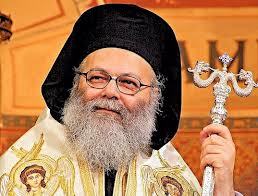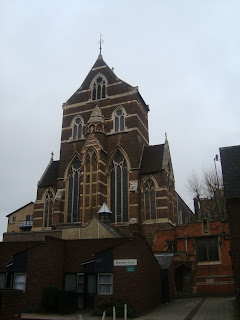
During Great Lent we follow the example set by our Lord Jesus Christ, Who fasted on our behalf forty days and forty nights (Matt. 4: 2).
Also during Holy Week, which comes after the 40 days, we live the Passion of Christ day-by-day and hour-by-hour. Because of the significance and holiness of Great Lent, the Church designated a week of preparation to precede the 40 days. The Church is teaching us to prepare for Great Lent in a spiritual manner. We fast to prepare ourselves for the 40 holy days. In fact, the preparatory week is not the only fast which the Church designated to get us ready for Great Lent and Holy Week. Two weeks prior to Great Lent there is Jonah’s Fast, also known as Nineveh’s Fast. It is a short fast, only three days, and it is a fast of repentance. During this fast, we live with Jonah his fasting and repentance in the whale’s belly. We also live with the Ninevites their fasting and repentance. Just as the fasting accompanied by repentance saved Jonah and the Ninevites from perdition, also our fasting accompanied by repentance will save us from eternal destruction and death due to sin.
Great Lent is an Apostolic Fast:
It is mentioned in the Didskalia (chapter 18) the following: "Great Lent should be honored before Holy Week. It starts on the Monday following the Saturday and is completed on the Friday preceding Holy Week. After it, you must pay great attention to Holy Week and fast it with fear and piety." In Canon 69 from the Canons of our Fathers the Apostles, the following is mentioned: "Any bishop, priest, deacon, reader, or chanter who does not fast Great Lent or Wednesdays and Fridays shall be excommunicated, unless he has a physical ailment. As for a lay person, he shall be excluded."
Great Lent is an Ascetical Fast:
The Church teaches us to fast until sunset. Fish is not allowed during this period. Also married couples should refrain from physical relations to give themselves time for fasting and prayer (1 Cor. 7: 5). We would like to emphasize the importance of the period of strict abstention during fasting. It is refraining from eating and drinking for a period of time, followed by eating vegetarian food.
Some people practice fasting by abstaining from meat and they eat vegetarian food, disregarding the period of strict abstention. These people should actually be regarded as vegetarians and not as fasting. A vegetarian eats only vegetarian food, but is not considered a fasting person. True fasting must be accompanied by abstention from food and drink until sunset as designated by the Church. However, due to variations in people’s physical and spiritual abilities, the Church gave the father of confession the authority to designate to his children the length of their strict abstinence. He determines what is suitable for their spiritual benefit according to the nature of their work, as well as their physical ability to endure fasting.
Great Lent is a Period of Prayer:
The period of Great Lent is distinctive for its many Liturgies. They become the spiritual treasure for the fasting person to help him throughout the rest of the year. In addition to the Divine Liturgy on Sundays, which have specific readings, hymns, and tunes, the Church also arranged special readings for the daily Liturgies during Great Lent. Also, during the weekdays, there are special hymns.
The Church celebrates the Divine Liturgy almost daily during Great Lent. It is preferred that these Liturgies start late in the day to offer those fasting the opportunity to practice strict abstinence.
It is not permitted to have the Divine Liturgy on weekdays early in the morning, since we pray the hours until the Compline Prayer. How can we pray the psalms of the Complin Prayer at 5:00 A.M.? Also, having an early morning Liturgy means there will not be abstention from food, since we can not abstain from food following the Divine Liturgy. The proper time to end the Divine Liturgy during the weekdays of Great Lent is at sunset. Due to the inability of the elderly and the sick, it is permitted to have it end earlier, but not before noon. That way everyone may receive the blessing of Holy Communion, while benefiting from abstention. We hope that the fathers of confession will take great care in guiding their children as to the importance of strict abstinence and how to struggle to keep it for as long as they can.
Great Lent is a Period of Repentance:
Fasting without repentance and changing one’s life becomes useless. Unless the fasting person changes his life during fasting, he will only be hungry and exhausted without gaining anything else. Therefore, the Church constantly reminds us of the importance of repentance during fasting. Before Great Lent, we fast Jonah’s Fast and we live the story of Jonah and the Ninevites’ repentance. During the third Sunday of Lent, the Holy Church offers us the Gospel reading of the Prodigal Son as a model of repentance, which requires an awakening, confession of sins, leaving the place of sin, and returning to the Heavenly Father with confidence in His mercies and acceptance. This parable reveals to us the depth of God’s love for sinners and how He accepts them no matter how horrendous their sin is. Our Lord Jesus Christ said, "the one who comes to Me I will by no means cast out." (John 6: 37) Christ "has come to save that which was lost." (Matt. 18:11) God desires that all men be saved and come to the knowledge of truth (1Tim. 2:4). Christ is the True Physician who is needed by those who are ill by sin. He did not come to call the righteous, but sinners to repentance (Mark 2: 17). Repentance is a result of divine action; it is the Spirit of God, Who moves the hearts of sinners to repent.
It is written in the Holy Bible, "For it is God who works in you both to will and do for His good pleasure." (Phil. 2: 13) God’s pleasure is in the return of a sinner so that he will not die in his sin. When God sees his sinful child returning to Him, He has compassion and goes to him, kissing him, and welcomes his return by saying, "It is right that we should make merry and be glad." (Luke 15: 32) The return of a sinner and his repentance results in joy to God, as well as all those in heaven, because, "there will be more joy in heaven over one sinner who repents than over ninety-nine just persons who need no repentance." (Luke 15: 7)
During Great Lent, we praise God for His many mercies. The Doxology of Great Lent presents to us a magnificent hymn in praising God on His mercies, as well as asking for His mercies. The first Doxology of the Sundays of Great Lent starts with the following:
I will praise you, O Lord, for your mercies are forever. From generation to generation, my mouth shall declare Your truth.
In this beautiful doxology, we praise God for His mercies. Then the chanter remembers his many sins and transgressions by saying, " My sins are heavy over my head." As his sins are revealed in front of him, he then remembers the stories of those who repented and were accepted by God, so he won’t lose hope. Therefore, he remembers the publican, the adulteress, and the thief and asks God to make him like any one of them.
Again, he recalls God’s attributes by saying, "I know You are good, kind and merciful. Remember me in Your mercy forever." God does not wish the death of a sinner but that he should return and live. Then the chanter remembers his sins once again and says: “I have sinned, O Jesus, my Lord, I have sinned, O Jesus, my God, O my King, do not count the sins I have committed.”
He asks for God’s mercies and not to be punished like Sodom and Gomorrah, but to have mercy on him like the Ninevites. The chanter ends his praise by saying: “But absolve and forgive My many transgressions As good and lover of mankind Have mercy on us according to Your great mercy.”
This doxology is beautiful poetry, through which the human soul expresses her feelings resulting from the heaviness of her sins. At the same time, she shows her great hope in our kind and merciful Lord, Who is happy with the return and repentance of the sinner. Yet, He punishes the unrepentant sinners. Therefore, repentance is the means by which we enjoy God’s great mercies.
Great Lent is a Period for Doing Mercy:
The Church reminds us of the importance of doing merciful acts during fasting. Therefore, during Great Lent we chant together praising those who have mercy on the poor. The Holy Bible teaches us that the fasting which is accepted by God is the one in which we do acts of mercy to others. "Is this not the fast that I have chosen: to loose the bonds of wickedness, to undo the heavy burdens, to let the oppressed go free, and that you break every yoke? Is it not to share your bread with the hungry, and that you bring to your house the poor who are cast out; when you see the naked, that you cover him, and not hide yourself from you own flesh?"
Fasting is a beautiful period to do good deeds by helping the poor, feeding the hungry, visiting the sick, and taking care of the needs of others. The person who fasts by not yielding to the needs of the flesh, will feel the needs of others and his heart will be moved to serve them. Also, the asceticism of fasting teaches us to care for the heavenly and not be concerned with the earthly. Thus it becomes easy to forsake our material possessions and offer them to the needy.
Great Lent is a Period of Reconciliation with Others:
Fasting is an act of worship presented to God, and God does not accept the offering and worship of a person who quarrels with others. Instead, He asks him to go and make peace with his brother before coming to worship and present offerings in front of God’ altar. Fasting is an appropriate time to evaluate our relationship with others. As we ask God to forgive us our sins, we must also forgive those who have sinned against us.
May God grant us a blessed fast by which we can grow in a life of prayer, asceticism, and repentance. May we always increase in doing acts of mercy and living in peace with one another













































